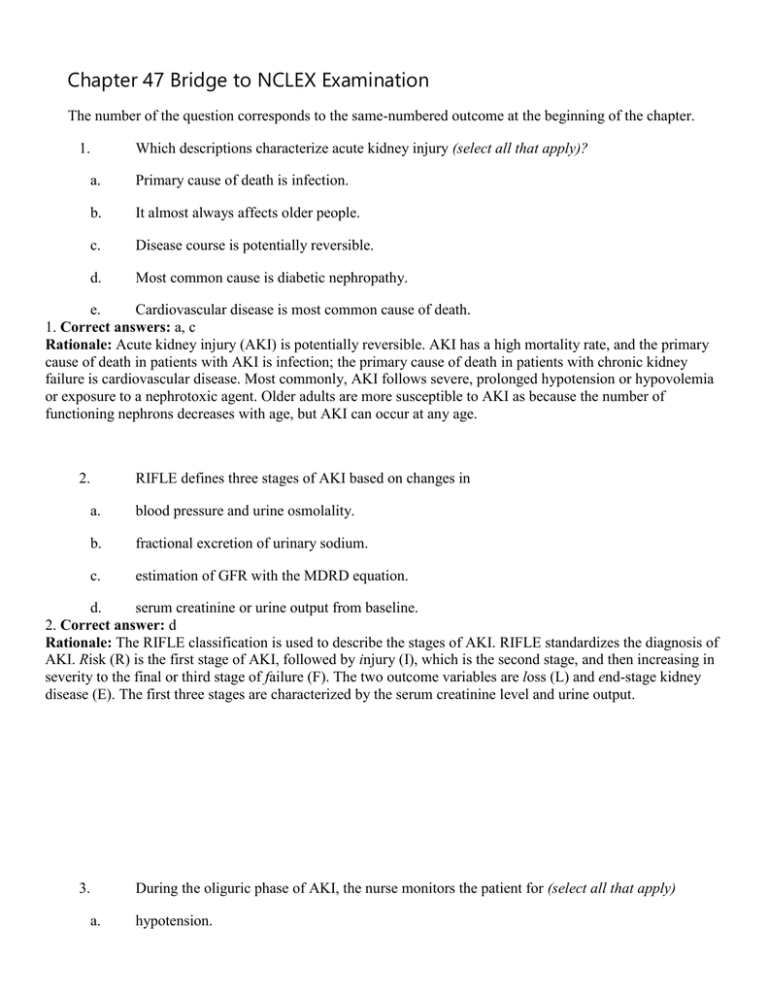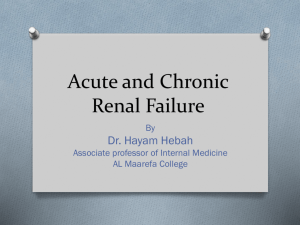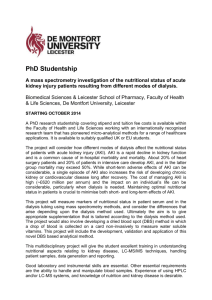Chap 47 Bridge
advertisement

Chapter 47 Bridge to NCLEX Examination The number of the question corresponds to the same-numbered outcome at the beginning of the chapter. 1. Which descriptions characterize acute kidney injury (select all that apply)? a. Primary cause of death is infection. b. It almost always affects older people. c. Disease course is potentially reversible. d. Most common cause is diabetic nephropathy. e. Cardiovascular disease is most common cause of death. 1. Correct answers: a, c Rationale: Acute kidney injury (AKI) is potentially reversible. AKI has a high mortality rate, and the primary cause of death in patients with AKI is infection; the primary cause of death in patients with chronic kidney failure is cardiovascular disease. Most commonly, AKI follows severe, prolonged hypotension or hypovolemia or exposure to a nephrotoxic agent. Older adults are more susceptible to AKI as because the number of functioning nephrons decreases with age, but AKI can occur at any age. 2. RIFLE defines three stages of AKI based on changes in a. blood pressure and urine osmolality. b. fractional excretion of urinary sodium. c. estimation of GFR with the MDRD equation. d. serum creatinine or urine output from baseline. 2. Correct answer: d Rationale: The RIFLE classification is used to describe the stages of AKI. RIFLE standardizes the diagnosis of AKI. Risk (R) is the first stage of AKI, followed by injury (I), which is the second stage, and then increasing in severity to the final or third stage of failure (F). The two outcome variables are loss (L) and end-stage kidney disease (E). The first three stages are characterized by the serum creatinine level and urine output. 3. During the oliguric phase of AKI, the nurse monitors the patient for (select all that apply) a. hypotension. b. ECG changes. c. hypernatremia. d. pulmonary edema. e. urine with high specific gravity. 3. Correct answers: b, d Rationale: The nurse monitors the patient in the oliguric phase of acute renal failure for the following: Hypertension and pulmonary edema: When urinary output decreases, fluid retention occurs. The severity of the symptoms depends on the extent of the fluid overload. In the case of reduced urine output (i.e., anuria and oliguria), the neck veins may become distended with a bounding pulse. Edema and hypertension may develop. Fluid overload can eventually lead to heart failure (HF), pulmonary edema, and pericardial and pleural effusions. Hyponatremia: Damaged tubules cannot conserve sodium. Consequently, the urinary excretion of sodium may increase, which results in normal or below-normal serum levels of sodium. Electrocardiographic changes and hyperkalemia: Initially, clinical signs of hyperkalemia are apparent on electrocardiogram (ECG) demonstrating peaked T waves, widening of the QRS complex, and STsegment depression. Urinary specific gravity: Urinary specific gravity is fixed at about 1.010. 4. If a patient is in the diuretic phase of AKI, the nurse must monitor for which serum electrolyte imbalances? a. Hyperkalemia and hyponatremia b. Hyperkalemia and hypernatremia c. Hypokalemia and hyponatremia d. Hypokalemia and hypernatremia 4. Correct answer: c Rationale: In the diuretic phase of AKI, the kidneys have recovered the ability to excrete wastes but not the ability to concentrate urine. Hypovolemia and hypotension can result from massive fluid losses. Because of the large losses of fluid and electrolytes, the patient must be monitored for hyponatremia, hypokalemia, and dehydration. 5. A patient is admitted to the hospital with chronic kidney disease. The nurse understands that this condition is characterized by a. progressive irreversible destruction of the kidneys. b. a rapid decrease in urine output with an elevated BUN. c. an increasing creatinine clearance with a decrease in urine output. d. prostration, somnolence, and confusion with coma and imminent death. 5. Correct answer: a Rationale: Chronic kidney disease (CKD) involves progressive, irreversible loss of kidney function. 6. Nurses need to teach patients at risk for developing chronic kidney disease. Individuals considered to be at increased risk include (select all that apply) a. older African Americans. b. patients more than 60 years old. c. those with a history of pancreatitis. d. those with a history of hypertension. e. those with a history of type 2 diabetes. 6. Correct answers: a, b, d, e Rationale: Risk factors for CKD include diabetes mellitus, hypertension, age older than 60 years, cardiovascular disease, family history of CKD, exposure to nephrotoxic drugs, and ethnic minority (e.g., African American, Native American). 7. Patients with chronic kidney disease experience an increased incidence of cardiovascular disease related to (select all that apply) a. hypertension. b. vascular calcifications. c. a genetic predisposition. d. hyperinsulinemia causing dyslipidemia. e. increased high-density lipoprotein levels. 7. Correct answers: a, b, d Rationale: CKD patients have traditional cardiovascular (CV) risk factors, such as hypertension and elevated lipids. Hyperinsulinemia stimulates hepatic production of triglycerides. Most patients with uremia develop dyslipidemia. Much CV disease may be related to nontraditional CV risk factors, such as vascular calcification and arterial stiffness, which are major contributors to CV disease in CKD. Calcium deposits in the vascular medial layer are associated with stiffening of the blood vessels. The mechanisms involved are multifactorial and incompletely understood, but they include (1) change of vascular smooth muscle cells into chondrocytes or osteoblast-like cells, (2) high total-body amounts of calcium and phosphate as a result of abnormal bone metabolism, (3) impaired renal excretion, and (4) drug therapies to treat the bone disease (e.g., calcium phosphate binders) 8. Nutritional support and management are essential across the entire continuum of chronic kidney disease. Which statements would be considered true related to nutritional therapy (select all that apply)? a. Fluid is not usually restricted for patients receiving peritoneal dialysis. b. Sodium and potassium may be restricted in someone with advanced CKD. c. Decreased fluid intake and a low potassium diet are hallmarks of the diet for a patient receiving hemodialysis. d. Decreased fluid intake and a low potassium diet are hallmarks of the diet for a patient receiving peritoneal dialysis. e. Increased fluid intake and a diet with potassium-rich foods are hallmarks of a diet for a patient receiving hemodialysis. 8. Correct answers: a, b, c Rationale: Water and any other fluids are not routinely restricted before end-stage kidney disease (ESKD). Patients receiving hemodialysis have a more restricted diet than do patients receiving peritoneal dialysis. Patients receiving hemodialysis are frequently educated about the need for a dietary restriction of potassiumrich foods. However, patients receiving peritoneal dialysis may actually require replacement of potassium because of the higher losses of potassium with peritoneal dialysis. Sodium and salt restriction is common for all patients with CKD. For those receiving hemodialysis, as their urinary output diminishes, fluid restrictions are enhanced. Intake depends on the daily urine output. In general, 600 mL (from insensible loss) plus an amount equal to the previous day’s urine output is allowed for a patient receiving hemodialysis. Patients are advised to limit fluid intake so that weight gains between dialysis sessions (i.e., interdialytic weight gain) are no more than 1 to 2 kg. For the patient who is undergoing dialysis, protein is not routinely restricted. The beneficial role of protein restriction in CKD stages 1 through 4 as a means to reduce the decline in kidney function is controversial. Historically, dietary counseling often encouraged restriction of protein for individuals with CKD. Although there is some evidence that protein restriction has benefits, many patients find these diets difficult to adhere to. For CKD stages 1 through 4, many clinicians encourage a diet with normal protein intake. However, patients must be taught to avoid high-protein diets and supplements because they may overstress the diseased kidneys. 9. An ESKD patient receiving hemodialysis is considering asking a relative to donate a kidney for transplantation. In assisting the patient to make a decision about treatment, the nurse informs the patient that a. successful transplantation usually provides better quality of life than that offered by dialysis. b. if rejection of the transplanted kidney occurs, no further treatment for the renal failure is available. c. hemodialysis replaces the normal functions of the kidneys, and patients do not have to live with the continual fear of rejection. d. the immunosuppressive therapy following transplantation makes the person ineligible to receive other forms of treatment if the kidney fails. 9. Correct answer: a Rationale: Kidney transplantation is extremely successful, with 1-year graft survival rates of about 90% for deceased donor organs and 95% for live donor organs. An advantage of kidney transplantation over dialysis is that it reverses many of the pathophysiologic changes associated with renal failure when normal kidney function is restored. It also eliminates the dependence on dialysis and the need for the accompanying dietary and lifestyle restrictions. Transplantation is less expensive than dialysis after the first year. 10. To assess the patency of a newly placed arteriovenous graft for dialysis, the nurse should (select all that apply) a. monitor the BP in the affected arm. b. irrigate the graft daily with low-dose heparin. c. palpate the area of the graft to feel a normal thrill. d. listen with a stethoscope over the graft to detect a bruit. e. frequently monitor the pulses and neurovascular status distal to the graft. 10. Correct answers: c, d, e Rationale: A thrill can be felt on palpation of the area of anastomosis of the arteriovenous graft, and a bruit can be heard with a stethoscope. The bruit and thrill are created by arterial blood rushing into the vein. The blood pressure should not be taken in the arm with the AV graft. 11. A major advantage of peritoneal dialysis is a. the diet is less restricted and dialysis can be performed at home. b. the dialysate is biocompatible and causes no long-term consequences. c. high glucose concentrations of the dialysate cause a reduction in appetite, promoting weight loss. d. no medications are required because of the enhanced efficiency of the peritoneal membrane in removing toxins. 11. Correct answer: a Rationale: Advantages of peritoneal dialysis include fewer dietary restrictions and the possibility of home dialysis. 12. A kidney transplant recipient complains of having fever, chills, and dysuria over the past 2 days. What is the first action that the nurse should take? a. Assess temperature and initiate workup to rule out infection. b. Reassure the patient that this is common after transplantation. c. Provide warm cover for the patient and give 1 g acetaminophen orally. d. Notify the nephrologist that the patient has developed symptoms of acute rejection. 12. Correct answer: a Rationale: The nurse needs to be astute in the observation and assessment of kidney transplant recipients because prompt diagnosis and treatment of infections can improve patient outcomes. Fever, chills, and dysuria indicate an infection. The temperature should be assessed, and the patient should undergo diagnostic testing to rule out an infection.




